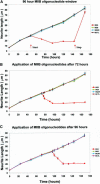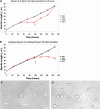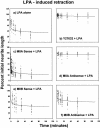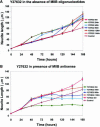Myosin IIA drives neurite retraction
- PMID: 12960431
- PMCID: PMC266780
- DOI: 10.1091/mbc.e03-03-0187
Myosin IIA drives neurite retraction
Abstract
Neuritic extension is the resultant of two vectorial processes: outgrowth and retraction. Whereas myosin IIB is required for neurite outgrowth, retraction is driven by a motor whose identity has remained unknown until now. Preformed neurites in mouse Neuro-2A neuroblastoma cells undergo immediate retraction when exposed to isoform-specific antisense oligonucleotides that suppress myosin IIB expression, ruling out myosin IIB as the retraction motor. When cells were preincubated with antisense oligonucleotides targeting myosin IIA, simultaneous or subsequent addition of myosin IIB antisense oligonucleotides did not elicit neurite retraction, both outgrowth and retraction being curtailed. Even during simultaneous application of antisense oligonucleotides against both myosin isoforms, lamellipodial spreading continued despite the complete inhibition of neurite extension, indicating an uncoupling of lamellipodial dynamics from movement of the neurite. Significantly, lysophosphatidate- or thrombin-induced neurite retraction was blocked not only by the Rho-kinase inhibitor Y27632 but also by antisense oligonucleotides targeting myosin IIA. Control oligonucleotides or antisense oligonucleotides targeting myosin IIB had no effect. In contrast, Y27632 did not inhibit outgrowth, a myosin IIB-dependent process. We conclude that the conventional myosin motor, myosin IIA, drives neurite retraction.
Figures







Similar articles
-
Asymmetric distribution of myosin IIB in migrating endothelial cells is regulated by a rho-dependent kinase and contributes to tail retraction.Mol Biol Cell. 2003 Dec;14(12):4745-57. doi: 10.1091/mbc.e03-04-0205. Epub 2003 Sep 5. Mol Biol Cell. 2003. PMID: 12960430 Free PMC article.
-
Distinct roles of nonmuscle myosin II isoforms in the regulation of MDA-MB-231 breast cancer cell spreading and migration.Cancer Res. 2006 May 1;66(9):4725-33. doi: 10.1158/0008-5472.CAN-05-4236. Cancer Res. 2006. PMID: 16651425
-
Separate but linked functions of conventional myosins modulate adhesion and neurite outgrowth.Nat Cell Biol. 2001 Jan;3(1):88-92. doi: 10.1038/35050613. Nat Cell Biol. 2001. PMID: 11146631
-
Molecular dissection of the Rho-associated protein kinase (p160ROCK)-regulated neurite remodeling in neuroblastoma N1E-115 cells.J Cell Biol. 1998 Jun 29;141(7):1625-36. doi: 10.1083/jcb.141.7.1625. J Cell Biol. 1998. PMID: 9647654 Free PMC article.
-
Nonmuscle myosin-2: mix and match.Cell Mol Life Sci. 2013 Jan;70(1):1-21. doi: 10.1007/s00018-012-1002-9. Epub 2012 May 8. Cell Mol Life Sci. 2013. PMID: 22565821 Free PMC article. Review.
Cited by
-
Non-Muscle Myosin II in Axonal Cell Biology: From the Growth Cone to the Axon Initial Segment.Cells. 2020 Aug 26;9(9):1961. doi: 10.3390/cells9091961. Cells. 2020. PMID: 32858875 Free PMC article. Review.
-
The effect of including the C2 insert of nonmuscle myosin II-C on neuritogenesis.J Biol Chem. 2013 Mar 15;288(11):7815-7828. doi: 10.1074/jbc.M112.417196. Epub 2013 Jan 25. J Biol Chem. 2013. PMID: 23355468 Free PMC article.
-
Conventional and Non-Conventional Roles of Non-Muscle Myosin II-Actin in Neuronal Development and Degeneration.Cells. 2020 Aug 19;9(9):1926. doi: 10.3390/cells9091926. Cells. 2020. PMID: 32825197 Free PMC article. Review.
-
Local glycolysis fuels actomyosin contraction during axonal retraction.J Cell Biol. 2023 Dec 4;222(12):e202206133. doi: 10.1083/jcb.202206133. Epub 2023 Oct 30. J Cell Biol. 2023. PMID: 37902728 Free PMC article.
-
Mechanism of Axonal Contractility in Embryonic Drosophila Motor Neurons In Vivo.Biophys J. 2016 Oct 4;111(7):1519-1527. doi: 10.1016/j.bpj.2016.08.024. Biophys J. 2016. PMID: 27705774 Free PMC article.
References
-
- Amano, M., Chihara, K., Nakamura, N., Fukata, Y., Yano, T., Shibata, M., Ikebe, M., and Kaibuchi, K. (1998). Myosin II activation promotes neurite retraction during the action of Rho and Rho-kinase. Genes Cells 3, 177-188. - PubMed
-
- Berg, J.S., and Cheney, R.E. (2002). Myosin X is an unconventional myosin that undergoes intrafilopodial motility. Nat. Cell Biol. 4, 246-250. - PubMed
Publication types
MeSH terms
Substances
Grants and funding
LinkOut - more resources
Full Text Sources

